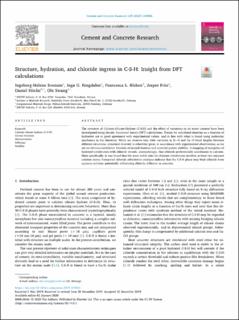| dc.contributor.author | Svenum, Ingeborg-Helene | |
| dc.contributor.author | Ringdalen, Inga Gudem | |
| dc.contributor.author | Bleken, Francesca Lønstad | |
| dc.contributor.author | Friis, Jesper | |
| dc.contributor.author | Hoche, Daniel | |
| dc.contributor.author | Swang, Ole | |
| dc.date.accessioned | 2020-11-10T13:01:15Z | |
| dc.date.available | 2020-11-10T13:01:15Z | |
| dc.date.created | 2020-01-20T14:58:32Z | |
| dc.date.issued | 2020 | |
| dc.identifier.issn | 0008-8846 | |
| dc.identifier.uri | https://hdl.handle.net/11250/2687127 | |
| dc.description.abstract | The structure of Calcium-Silicate-Hydrate (C-S-H) and the effect of variations in its water content have been investigated using density functional theory (DFT) calculations. Trends for calculated densities as a function of hydration are in good agreement with experimental values, and in line with what is found using molecular mechanics in the literature. While we observe very little variation in Sisingle bondO and Casingle bondO bond lengths between different structures, structural diversity is otherwise great, in accordance with experimental observations, as we see no obvious correlation between structural features and material system stability. A mapping of energetics of hydroxyl substitution with chloride reveals, unsurprisingly, that chloride preferentially coordinates to calcium. More specifically, it was found that the most stable sites for chlorine substitution involves at least two adjacent calcium atoms. Computed chloride substitution energies indicate that the C-S-H phase may bind chloride from aqueous solution, potentially influencing chloride diffusion in concrete. | en_US |
| dc.language.iso | eng | en_US |
| dc.publisher | Elsevier | en_US |
| dc.rights | Navngivelse 4.0 Internasjonal | * |
| dc.rights.uri | http://creativecommons.org/licenses/by/4.0/deed.no | * |
| dc.subject | Stability | en_US |
| dc.subject | Diffusion | en_US |
| dc.subject | Microstructure | en_US |
| dc.subject | Crystal structure | en_US |
| dc.subject | Calcium-silicate-hydrate (C-S-H) | en_US |
| dc.title | Structure, hydration, and chloride ingress in C-S-H: Insight from DFT calculations | en_US |
| dc.type | Peer reviewed | en_US |
| dc.type | Journal article | en_US |
| dc.description.version | publishedVersion | en_US |
| dc.rights.holder | © 2020 The Authors. Published by Elsevier Ltd. This is an open access article under the CC BY license (http://creativecommons.org/licenses/BY/4.0/). | en_US |
| dc.subject.nsi | VDP::Fysikalsk kjemi: 443 | en_US |
| dc.subject.nsi | VDP::Physical chemistry: 443 | en_US |
| dc.subject.nsi | VDP::Fysikalsk kjemi: 443 | en_US |
| dc.subject.nsi | VDP::Physical chemistry: 443 | en_US |
| dc.source.pagenumber | 11 | en_US |
| dc.source.volume | 129 | en_US |
| dc.source.journal | Cement and Concrete Research | en_US |
| dc.identifier.doi | 10.1016/j.cemconres.2019.105965 | |
| dc.identifier.cristin | 1778089 | |
| dc.relation.project | EC/H2020/685445 | en_US |
| dc.relation.project | Notur/NorStore: NN9355k | en_US |
| dc.relation.project | Notur/NorStore: NN2147K | en_US |
| dc.source.articlenumber | 105965 | en_US |
| cristin.ispublished | true | |
| cristin.fulltext | postprint | |
| cristin.qualitycode | 2 | |

